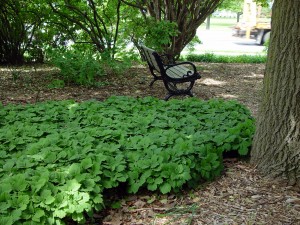Weeding is one of those gardening tasks that some people find peaceful and enjoyable and others HATE! Weeding is a component of gardening but it doesn’t have to consume all your gardening time. Here are some strategies to help control weeds:
Use groundcover in your landscape beds to compete with weeds. Most landscapes should have three layers—tree layer, shrub layer and groundcover. When landscape designers, draw landscape plans, they tend to draw in large circles for the trees and smaller shrub circles, but often neglect to specify plants below the shrubs to cover the ground. Few shrubs branch to the ground completely and therefore require a layer of plants below them to prevent weeds from growing in the bed. The University of Delaware gets a lot of mileage from lilyturf (Liriope spicata) as a tough groundcover that out competes most weeds. But, if you want more variety, you can try lamb’s ears (Stachys byzantina), bugleweed (Ajuga reptans), sweet woodruff (Galium odoratum), Allegheny pachysandra (Pachysandra procumbens)—a great native that takes a little while to establish but fills in thickly once it gets going, Christmas fern (Polystichum aristicoides) or barrenwort (Epimedium sp.)—a great plant for dry shade. Also consider planting perennials to fill in spaces rather than just shrubs. Catmint (Nepeta x faassenii ‘Walker’s Low’) is a great perennial that grows densely and out competes most weeds. It is blooming now in Delaware gardens. If you have a large space to fill, you might try mountain mint (Pycnanthemum muticum). It is a vigorous grower and could become a problem in a small garden but its mid-summer flowers last until September in the form of silvery bracts. It is also one of the best nectar sources for butterflies and bees so it is great to include in a pollinator garden.
Another weed control strategy is to cover the landscape bed with mulch. Mulch will prevent light from reaching the soil, so few annual weeds are able to germinate. You can generate your own mulch with composted yard waste and ground up leaves. You can also buy leaf mulch or hardwood bark mulch. Use mulch as a temporary feature, until your plants fill in or at the edges of beds to differentiate the landscape bed from the lawn.
Herbicides can be used carefully to control weeds as well. Pre-emergent herbicides are used to control annual weeds before they emerge, by setting up an herbicide barrier in the soil. It is a little late to apply a pre-emergent product this year, but something to consider for landscape beds next year. Selective post-emergent herbicides can be used to control grass in landscape beds or broad-leaved weeds in lawns. You can also use a glyphosate product (Roundup is one example) to spot spray weeds, but be careful because glyphosate kills most green plant tissue it touches. It is easy to get spray drift and damage desirable plants.
Finally, readjust your attitude about weeding. Bring a cushion and a glass of iced tea outdoors with you. Put on a good pair of gardening gloves. Have a weed bucket nearby and spend a little time each weekend or evening relaxing in your garden and pulling up a few weeds.



